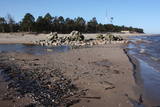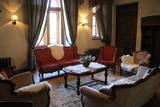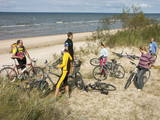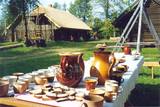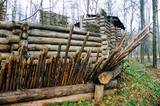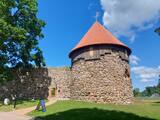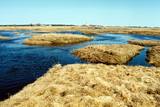| Nr | Nosaukums | Apraksts |
|---|---|---|
|
Izteiktākais Latvijas piekrastes zemesrags, kur vērojama Baltijas jūras (Dižjūra) un Rīgas jūras līča (Mazjūra) viļņu saskares vieta. Vētru laikā te viens pret otru sitas līdz pat 7 metrus augsti viļņi. Rags kā zemūdens sēklis turpinās līdz 5 km attālajai Kolkas bākai. To cēla uz mākslīgas salas, ko uzbēra 1872. – 1875. g. Kad sala nosēdās, 1883. g. uz tās uzcēla tagadējo – 21 m augsto bākas torni (izgatavots Sanktpēterburgā), kas sāka darboties 1884. g. 1. jūlijā. Mūsdienās uz salas atrodas bākas uzrauga ēka un vairākas saimniecības ēkas, kā arī iespaidīgs miglas zvans. Kolkasragā uzstādīts tēlnieka Ģ. Burvja piemineklis “Jūras paņemtajiem”, apskatāms koka kuģa vraks (domājams, no 19. gs.), akmens –Eiropas sirds (K. Valdemārs šo vietu uzskatīja par Eiropas centru), K. Valdemāram veltītie informācijas stendi un kādreizējā PSRS armijas krasta apsardzes spēku bāze, ko izmanto Latvijas robežsardze. Migrāciju laikā Kolkasrags ir Ziemeļeiropas mērogā nozīmīga caurceļojošo gājputnu koncentrēšanās un atpūtas vieta. Kolkasragā izveidots apmeklētāju centrs un vasaras kafejnīca. Kolkasraga apkārtnē zem ūdens atrodas Baltijas jūras lielākā kuģu kapsēta. Peldētājiem šī ir bīstama vieta nepastāvīgo straumju un kustīgo smilšu dēļ. Kolkasraga galā apskatāmas Vecās bākas drupas – 18. gs. celtā dienvidu torņa (ziemeļu torni noskaloja 19. gs. otrajā pusē) atliekas. |
||
|
Pils tika būvēta tā, lai būtu gandrīz kopija Vindzoras pilij Anglijā. Šī ir viena no neierastākajām muižām Igaunijā. Tā ir tikpat interesanta kā tās īpašnieks - Frīdrihs fon Bergs. Aiz pils ir dendrārija parks ar reti sastopamām sugām. |
||
|
Krimuldas pili cēla 13. gs. otrajā pusē. Tā ir vieta, kur Gaujas senlejas labo pamatkrastu pāršķeļ dziļā Vikmestes grava. Pils (saimniekoja Rīgas domkapituls – Rīgas arhibīskapu padome) bija iespaidīga celtne, kuras plašo iekšpagalmu ietvēra 1,5 m biezs aizsargmūris. 1601. g. atkāpjoties, Krimuldas pili uzspridzināja zviedru karavadonis Heinrihs Līvens. Tagad ar mežu apaugušajā pilskalnā apskatāms neliels pils mūra fragments. Pie Krimuldas pilsdrupām ir meklējams Siguldas Gaisa tramvajs un sākas Krimuldas Serpentīna ceļš – vienīgais šāda veida objekts Baltijas valstīs. |
||
|
Slīteres nacionālo parku (dibināts 2000. g.) pamatoti dēvē par Baltijas jūras iepriekšējo attīstības stadiju „brīvdabas muzeju”. Šo ģeoloģisko notikumu mūsdienu „dzīvi” liecinieki ir Šlīteres Zilie kalni – stāvā, līdz 20 – 30 m augstā Baltijas ledus ezera senkrasta kāple (Baltijas jūras stadija pirms 10 000 gadu), Stiebru kalni – Ancilus ezera senkrasts (pirms 8 – 9 tūkstošiem gadu ), bet Eiropā lielākā – kangaru (kāpu vaļņi) un vigu (mitras starpkāpu ieplakas) ainava ir Litorīnas jūras laika veidojums (pirms 4 – 7 tūkstošiem gadu). Maigais Ziemeļkurzemes klimats ir iemesls daudzu Latvijā retu augu (liela daudzveidība, ap 860 augu sugu, t.sk. reti sastopamā parastā īve un Baltijas efeja) sastopamībai. Sava veida „nopelns” šejienes dabas vērtību saglabāšanā ir bijis arī jūras piekrastē kādreiz pastāvošajam padomju militāram režīmam, kura dēļ tā pusgadsimta garumā saglabājās apmeklētāju un būvniecības ziņā mazskarta. Tā laika liecinieki ir pamestās PSRS armijas bāzes un dažādi militārie objekti. Slīteres nacionālā parkā atrodas viens no populārākajiem Latvijas tūrisma objektiem – Kolkas rags, kuru gada laikā apmeklē vairāk nekā 50 000 ceļotāju, bet putnu pavasara migrāciju laikā stundas laikā pār to pārlaižas desmitiem tūkstoši putnu. Baltijas jūras krasta posmā – t.s. „Lībiešu krastā” no Kolkas līdz Sīkragam un Ovīšiem ir saglabājušies pasaulē mazākās minoritātes – lībiešu zvejniekciemi un citi to kultūras liecinieki. Tūristu vajadzībām izveidotas četras dabas takas, velomaršruti, skatu tornis, apmeklējama Šlīteres bāka u.c. Nacionālā parka administrācija regulāri organizē vides izglītības pasākumus, ka pieejami ikvienam interesentam.
|
||
|
No Kokneses muižas ēkām līdz mūsdienām ir saglabājusies pārvaldnieka ēka, kurā laikā no 1885. - 1887. g. dzīvojis latviešu rakstnieks Rūdolfs Blaumanis (1863. – 1908., uzstādīta piemiņas plāksne) un mūra stallis, kas celts no laukakmeņiem. Tajā atrodas a/s „Latvijas Valsts meži” Vidusdaugavas mežniecība. Kokneses vidusskolas akmens vārti ir bijušās muižas vārti. Muižas ēkas apskatāmas g.k. no ārpuses. |
||
|
Māla darbus apdedzina melnā (svēpētajā) tehnikā un strādā ar Latgalē rakto mālu. Darbu tapšanas procesā neizmanto industriālās iekārtas, cepli kurina ar malku. Demonstrē trauku tapšanu uz kājminamās podnieka ripas un stāsta par apdedzināšanas procesu. Apmeklētāji var darboties ar mālu un iegādāties darbus. |
||
|
Viscaur mežiem klāta sala Somu līcī ~ 14 km Z no Tallinas. Salu caurauž nelielu ceļu un taku tīkls. Ieteicams pārgājiens apkārt mainīgajai (kāpas, smilšaini, akmeņaini un ar niedrēm apauguši krasta posmi) salas piekrastei (~ 9 km). Kuģītis atiet no Piritas ostas.
|
||
|
Atrodas Jēkabpilī, Daugavas kreisajā krastā, Filozofu ielā 6. Ar šo vietu var uzsākt Sēlijas novada kultūrvēstures padziļinātu izziņu. Muzeja izveide uzsākta 1952. g. un te apskatāma 19. gs. Sēlijas vidēji turīga zemnieka lauku sēta, kurā ir dzīvojamā ēka ar apvalkdūmeni, divas klētis, rija, pirts, vējdzirnavas un kalve, kā arī tvaika lokomobīle un kuļammašīna. Tūristu grupām te piedāvā tematiskus pasākumus: „Amatnieku darbi Sēļu sētā”, „Kad medus kūst uz mēles” un „Precības sēļu sētā”. |
||
|
Saimniecībā nodarbojas ar biškopību. Piedāvā bišu produktus un bišu vaska sveču liešanu, kā arī izbraucienu ar 4/4 automašīnu pa bezceļa trasi, pirti un nakšņošanu. Degustācijai medus maisījumi. Īpašais piedāvājums - mājās cepta maize ar medu. Ar izglītojošu programmu pēc pieprasījuma izbrauc uz skolām un pasākumiem.
|
||
|
19. gadsimtā izveidojās neliels ciems Skultes jūrmalā, kuru apdzīvoja zvejnieki. Nosaukums Zvejniekciems radās no iedzīvotāju pamatnodarbošanās. 1967. gadā Skultes Zvejniekciema daļa pievienojās Saulkrastu pilsētciematam. Šodien Zvejniekciemā darbojas Skultes osta, kuru svinīgi atklāja 1939. gada 7. oktobrī. Akmens, ko izvēlējies Kārlis Ulmanis kā ostas būves liecinieku, joprojām atrodas Zvejniekciemā, un ostā arī šodien notiek aktīva darbība. Starp Skultes ostu un Saulkrastu pludmali atrodas Zvejniekciema akmeņainā pludmale. |
||
|
Atrodas Lielvārde centrālajā daļā, Rīgas - Daugavpils šosejas (A 6) malā. Latvijā šobrīd vienīgais šāda veida objekts - 12. gs. senlatviešu koka pils atdarinājums, kas tapis mākslinieka Agra Liepiņa vadībā. Tās vizualizācija ir balstīta uz dažādās Latvijas vietās atrasto seno būvju atlieku izpētes rezultātiem kā autora versija par Lielvārdes novada vecākā - Uldevena rezidenci. Koka pils iekšpusē var apskatīt 12. - 13. gs. senlatviešu cietokšņa aizsargbūvju un dzīvojamo ēku imitācijas, seno tērpu rekonstrukcijas, kā arī pašiem uzcept desiņas uz ugunskura. Kāziniekiem tiek piedāvātas dažādas atrakcijas. |
||
|
Viesu namā var apskatīt viesu nama lepnumu – pagrabu –, kurā atrodas liela saimniecībā gatavoto vīnu kolekcija. Saimniecībā var iegādāties ābolu, vīnogu, ķiršu, upeņu, dzērveņu, ērkšķogu un rabarberu vīnu. |
||
|
Līdzmūsdienām ir saglabājusies vecā - 18. gs. vidū klasicisma stilā celtā vecā kungu māja (šobrīd netiek izmantota, skaisti sīkrūšu logi!) un tai iepretim - pēc 1905. g. ugunsgrēka atjaunotā (1912. – 1913. g., neoklasicisma stils) jaunā pils, kurā atrodas Īvandes pagasta pārvalde, bibliotēka un jauniešu tūristu mītne. Ēkā saglabājušies atsevišķi interjera elementi – parketa grīdas, koka kāpnes u.c. Muižas parkā joprojām zaļo Baltijā lielākā Eiropas baltegle. Tās augstums pārsniedz 32 m, apkārtmērs - 4 m. Parkā izveidota atpūtas vieta. |
||
|
The tour begins in Riga with its Art Nouveau district and Old Town. Make your way to Sigulda by train. A hilly road passes Gutmana Cave, Turaida Castle and Krimulda Castle which stand on the hillsides of the Gauja river valley. The road continues to Limbaži, which is a typical Latvian provincial town. Further on you reach the Baltic Sea coast and Salacgriva, which is famous for its fishing traditions and lamprey. Outside Salacgrīva town there are rare coastal meadows and lagoons. After crossing the Latvian-Estonian border point, the road winds through old coastal villages - Ikla, Treimani, Kabli and Häädemeeste before rejoining the Via Baltica. At Pärnu explore Ruutli pedestrian street and the old fortifications. It is time to cross to the islands - the route passes through the small island of Muhu. Visit the local fish cafe at Livi and ethnographic fishermens’ village of Koguva. Then the route leads to Saaremaa island over a causeway. The main sites on the route are 'Valjala maalinn' – one of the most attractive hill forts in Estonia, the Valjala church, and meteorite craters of Kaali. By bus you head to the Estonian capital, Tallinn, charming with its medieval Old Town. From there take a tour of a former Soviet submarine base at Paldiski, a memorable reminder of recent history. |
||
|
Durbes pils saimniecības ēkā var vērot keramiķes darbu, pašiem iemēģināt roku, pasūtīt darbus un iegādāties suvenīrus no māla. Apskatāms Durbes pils komplekss, kurā šobrīd (2013. g.) norit restaurācijas darbi. |
||
|
1342.gadā lielākajā no Alūksnes ezera salām – Pilssalā – Livonijas ordenis pabeidza mūra pils celtniecību. Pili iesvētīja Marijas pasludināšanas dienā, tāpēc šī vieta ieguva sev jaunu nosaukumu Marienburga. Alūksnieši joprojām piemin Alūksnes meiteni Mariju, kura it kā iemūrēta vienā no pils sienām, tāpēc salu dēvē gan par Pilssalu, gan Marijas salu. Gadsimtu laikā mainījās pils valdnieki, tā piederēja gan krieviem, gan zviedriem, gan poļiem. Ir atjaunots Livonijas ordeņa pils priekšpils Dienvidu tornis– vienīgais no senās viduslaiku pils astoņiem torņiem, kas būtiskā vēsturiskā apjomā ir saglabājies līdz mūsdienām. Šobrīd Dienvidu tornī apskatāma mūzikas un gaismas ekspozīcija "MARIENBURGAS astotais brālis”, kas ir iztēli rosinošs un emocijām piesātināts piedzīvojums. Ekspozīcijas tapšanas procesā apvienojušies vairāki izcili mākslinieki: dramaturgs Lauris Gundars, komponisti Mārtiņš Brauns un Artūrs Maskats, skaņas dizaineris Sigvards Kļava un dizaina birojs H2E. Teiksmu ar Ojāra Vācieša vārdiem iedzied Latvijas Radio koris. Pieejamība: Dabas objekts ir pieejams cilvēkiem ar pārvietošanās grūtībām. |
||
|
Saimniecībā tiek audzēti alpakas, lamas, kamieļi, ēzeļi, strausi, holandiešu āži, šinšilas un truši. Kopā ar saimniekiem dzīvniekus var pabarot, paglaudīt un kopā nofotografēties. Saimniecībā ir ierīkotas lapenes. Kafejnīcā var pacienāties ar kafiju un uzkodām. Tāpat var iegādāties suvenīrus un alpaku vilnas izstrādājumus. |
||
|
Maršruts iepazīstina ar Vidzemes dienviddaļas mājražotājiem, zemnieku saimniecībām, a/s u.c., kas ražo dažādus piena pārstrādes produktus – pienu, jogurtus, biezpienu, sieru, saldējumu u.c. To var sākt Rīgā, turpinot ceļu pa Vidzemes šoseju un tālāk pagriežoties Mālpils virzienā. Līdz Ērgļiem un Jumurdai varēs apjūsmot Vidzemes augstienes pakalnus un gleznās ainavas. Ērgļu apkaimē var apmeklēt R. Blaumaņa „Brakus” un brāļu „Jurjānu” Meņģeļus, kā arī Jumurdas muižu. Tālākais ceļš vedīs cauri Cesvainei, kas pazīstama ar iespaidīgo pili un Madonai, kur varam ieturēt garšīgu maltīti. No Madonas gar ainaviskajiem Daugavas krastiem dodamies uz Koknesi (Likteņsala, Kokneses pils, parks un baznīca), Skrīveriem – A. Upīša dzimteni, apmeklējot gan Skrīveru mājas saldējumu, gan vietu, kur ražo visiem pazīstamo konfeti „Gotiņa”. Braucienu noslēdzam Ogrē („Sierštelles” sieri) un tālāk – Rīgā. |
||
|
Meklējama pilsētas centrā - Tirgus laukumā 11. Dievnams uzcelts 1886. g. Ēkā atrodas vairāki nozīmīgi mākslas pieminekļi – gleznas, krucifikss (18. gs.) u.c. Baznīcas dārzā apskatāma skulptūra “Latgales māte” (tēlnieks B. Buls) un piemineklis politiski represēto piemiņai (tēlniece V. Dzintare). Baznīca ir apskatāma arī no iekšpuses. |
||
|
Igaunijas vizuāli izteiksmīgākais karsta lauks 125 ha platībā ar dažādām karsta procesu izpausmēm – pazemes strautiem, Jēlehtmes (Jõelähtme) upes sausgultni, karsta avotiem, piltuvēm, gravām, alām, pamatiežu atsegumiem, savdabīgu akmens „sēni” u.c. Pavasaros tas applūst, bet mazūdens periodā labi apskatāmas minētās karsta formas.
|
||
